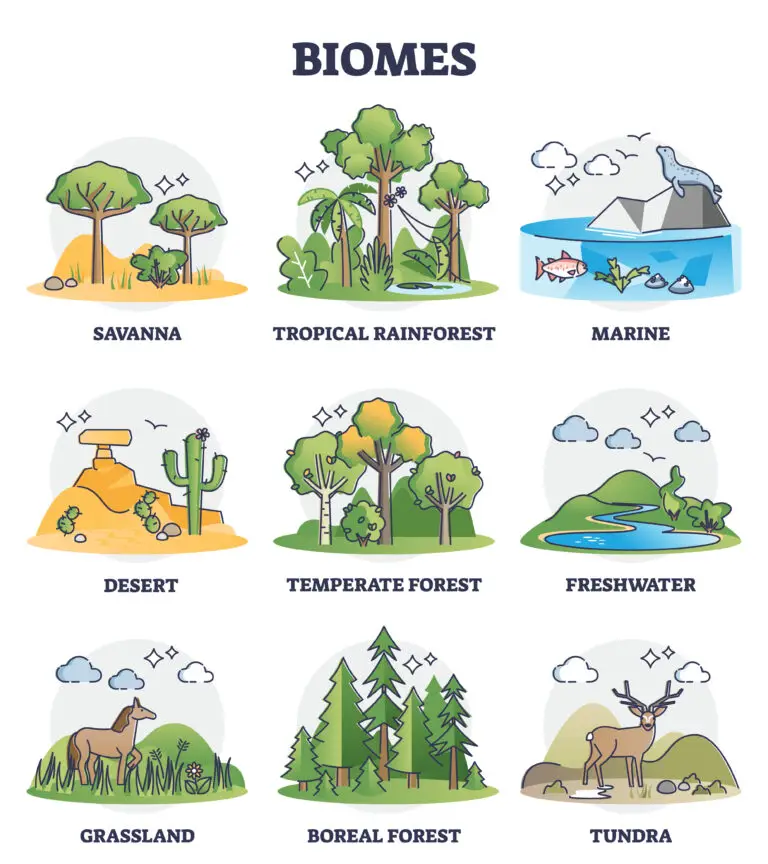Biome

Table of Contents
What is a Biome?
A biome is a large geographic biotic unit characterized by distinct abiotic and biotic factors that influence the types of organisms that can thrive in that region.
Biomes are major ecological zones on Earth, each with its unique climate, vegetation, and animal life. They are defined by specific temperatures, precipitation, and other environmental factors that shape the ecosystems within them.
Overview of Biomes
Climate
The climate of a biome plays a pivotal role in shaping its environment, determining the types of vegetation and animal life that can survive and thrive there. For example, a desert biome, characterized by low precipitation and high temperatures, will support plant and animal species adapted to dry and hot conditions.
Conversely, a rainforest biome, with high levels of rainfall and warm temperatures year-round, will be home to a diverse array of plant and animal species suited to these moist and humid conditions. Thus, the climate fundamentally defines the ecological structure and biological diversity of a biome.
Vegetation
The vegetation in a biome, or the types of plants present, is heavily influenced by the climate and soil conditions of the area. Factors like temperature, rainfall, and the quality and type of soil determine what kind of plant life can thrive.
Consequently, biomes are often categorized based on their dominant plant life. For example, forests are characterized by a high density of trees, grasslands by abundant grasses and few trees, deserts by drought-resistant plants like cacti, and tundras by hardy, low-growing vegetation. Each of these plant types has adapted to the specific conditions of its biome, illustrating the close relationship between the environment and the vegetation it supports.
Geography
Latitude affects the amount of solar energy an area receives, influencing its climate and the type of biome that can exist there. For example, tropical rainforests are found near the equator, while tundras are located in polar regions. Altitude also plays a crucial role; higher altitudes have cooler temperatures, leading to mountainous biomes that differ from those at sea level. Additionally, the proximity to bodies of water can moderate a region’s climate, making it more suitable for certain biomes.
Coastal areas, for instance, often have milder climates and more diverse ecosystems than inland areas at the same latitude. These geographical factors collectively determine the distribution and characteristics of biomes around the world.
Biotic Interactions
Each biome supports a unique species community adapted to its specific environmental conditions. These interactions can take various forms, such as predation, competition, symbiosis, and mutualism, shaping the structure and dynamics of the ecosystem.
For example, in a forest biome, trees may provide shelter and food for various animals and insects, while these animals and insects may pollinate plants or control pest populations. These complex and interdependent relationships contribute to the biodiversity and resilience of the biome, influencing its productivity and stability.
Ecosystem Services
Biomes play a vital role in providing ecosystem services, which are the benefits that natural systems offer to humans and other organisms. These services include offering habitat for diverse organisms, regulating the climate by sequestering carbon dioxide, filtering water to maintain water quality, and cycling nutrients to support plant and animal life.
For example, forests act as carbon sinks, absorbing large amounts of CO2 from the atmosphere, while wetlands filter pollutants from water, improving its quality. Grasslands contribute to soil formation and nutrient recycling, supporting wild and agricultural ecosystems. These ecosystem services are crucial for maintaining the planet’s health and supporting its inhabitants’ life and well-being.
Major Terrestrial Biomes
Tropical Rainforest:
- Characterized by high temperatures, abundant rainfall, and lush vegetation. It harbors diverse plant and animal species.
Temperate Deciduous Forest:
- Experiences four seasons with deciduous trees that shed their leaves in the fall. Common in regions with moderate temperatures.
Coniferous (Taiga) Forest:
- Dominated by coniferous trees like pines and spruces. Found in high-latitude regions with cold winters.
Tundra:
- Cold and treeless biome with low temperatures. Permafrost is present, and vegetation is adapted to harsh conditions.
Desert:
- Characterized by low precipitation levels and high temperatures. Vegetation is adapted to arid conditions.
Grassland:
- Dominated by grasses and lacking large trees. Divided into tropical, temperate, and cold grasslands based on location and climate.
Chaparral:
- Found in regions with mild, wet winters and hot, dry summers. Dominated by shrubs and adapted to periodic fires.
Savanna:
- Combines characteristics of grasslands and forests. Marked by distinct wet and dry seasons, supporting grasses and scattered trees.
Aquatic Biomes
Freshwater Biomes:
- Include rivers, lakes, ponds, and wetlands. They are characterized by low salt concentrations.
Marine Biomes:
- Include oceans, coral reefs, and estuaries. They have high salt concentrations and diverse marine life.
Related Links
Abiotic Factors
Organisms
Ecosystem
Biodiversity